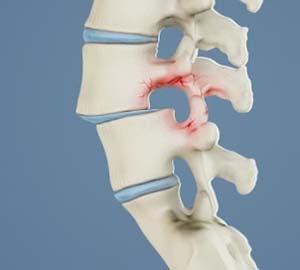Spondylolisthesis

What is Spondylolisthesis?
Spondylolisthesis is the displacement of the vertebral disk from the spinal column. Outward (forward) displacement is termed as anterolisthesis and inward (backward) displacement is termed as retrolisthesis. This condition is often preceded by spondylolysis, a degenerative condition of the vertebra.
Types of Spondylolisthesis
Based on the cause of displacement, five subtypes of spondylolisthesis are identified, they are:
- Dysplastic spondylolisthesis
- Isthmic spondylolisthesis
- Degenerative spondylolisthesis
- Traumatic spondylolisthesis
- Pathologic spondylolisthesis
Among the various subtypes of spondylolisthesis, the two most common forms observed are dysplastic spondylolisthesis (congenital condition caused because of abnormal bone formation of the facet part of the vertebra resulting) and isthmic spondylolisthesis (defect in the pars interarticularis part of the vertebra, which more common in athletes and gymnasts as they often suffer from overuse injuries).
Causes of Spondylolisthesis
The cause for spondylolisthesis is multifactorial; the common causes are overuse injuries of the spine, congenital abnormalities, trauma, bone disorders, and fractures.
Signs and Symptoms of Spondylolisthesis
The signs and symptoms that suggest spondylolisthesis include:
- Lower back pain
- Stiffness in the back and tightening of the hamstring muscles from spasms
- Pain in the thighs and buttocks
- Decreased range of motion of the lower back
- Pain and weakness of the legs or numbness because of nerve compression
- Loss of control on bowel or bladder function by severe nerve compression
- Increase in lordosis curve, also called swayback
- Kyphosis (round back)
Diagnosis of Spondylolisthesis
The treatment for spondylolisthesis is based on the diagnosis made by collecting your medical and family history, performing a physical examination and ordering radiographic scans. During the diagnosis, the severity of displacement is also assessed which is expressed as grade I to IV.
Treatment for Spondylolisthesis
In mild conditions and for symptomatic relief, conservative treatments including medications, bracing and physical therapy are recommended.
In severe cases, surgical correction with decompression laminectomy followed by spinal fusion is recommended. The procedure involves the removal of a portion of the vertebra compressing the nerves and other vertebrae, followed by the removal of a disk between the vertebrae and fusion of adjacent vertebrae. Fusion surgery is performed to confer stability to the spine. Following the surgery, your surgeon recommends physical therapy and rehabilitation programs to regain strength to the surrounding bones and muscles as well as to make you active soon.
- Posterior Lumbar Fusion
- Transforaminal Lumbar Interbody Fusion (TLIF)
- Extreme Lumbar Interbody Fusion (XLIF)
- Oblique Lumbar Interbody Fusion (OLIF)
- Image-Guided Spine Surgery
- Minimally Invasive Spine Surgery
